Global Private Equity Report

At a Glance
- Private equity took a big second-quarter hit from Covid-19 but recovered with impressive speed as the year wore on.
- Deal value, exits, fund-raising and returns all ended up relatively strong.
- A drop-off in deal numbers left pent-up demand for investments in 2021, but navigating a post-Covid world will require strong due diligence and deep sector expertise.
This article is part of Bain's 2021 Global Private Equity Report.
It was a year of massive disruption—and private equity emerged unscathed.
Despite the tragic Covid-19 pandemic and its global economic fallout, despite the protests against police brutality and systemic racism and months of social upheaval, despite a bitterly contested US presidential election that ultimately led to an unprecedented mob assault on Capitol Hill, dealmakers kept making deals in 2020, while exits and fund-raising fell in line with robust five-year averages (see Figure 1).
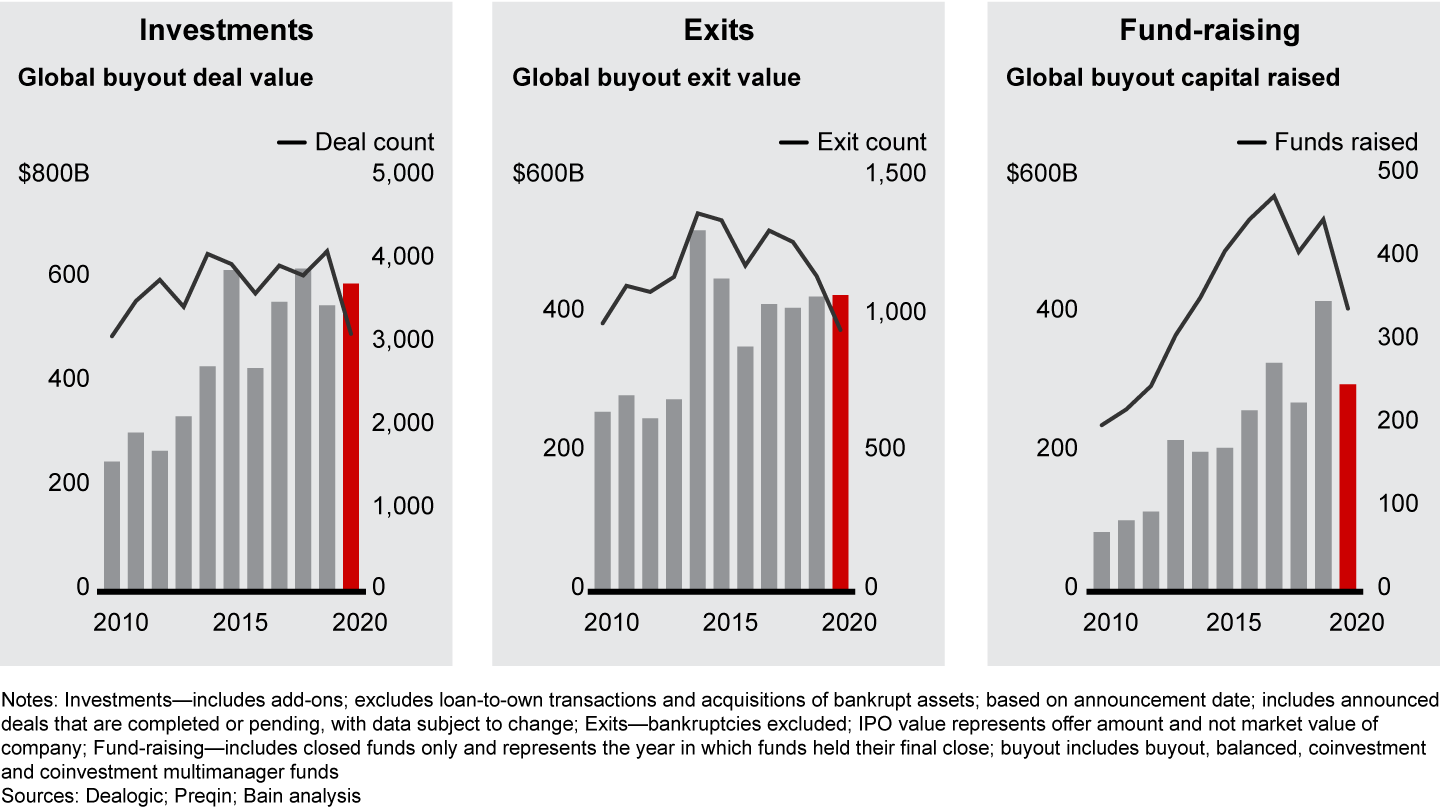
Like much else across the global economy, private equity activity fell off a cliff in April and May as buyers and sellers alike absorbed the initial shock of government stay-at-home orders. But even as total deal count remained subdued throughout the year in most sectors, deal and exit value snapped back vigorously in the third quarter. In terms of putting large chunks of money to work, the year’s second half ended up being as strong as any two-quarter run in recent memory (see Figure 2).

What’s also evident is that the overall 24% drop in deal count during the year left plenty of unfinished business. Based on heavy global activity in early 2021, pent-up demand will likely have a strong positive impact on current-year deal numbers. All indicators suggest that funds will continue to chase deals in the sectors least affected (or actually enhanced) by the ongoing Covid-19 crisis.
In some respects, the industry’s quick rebound isn’t surprising: One of private equity’s enduring strengths is its ability to thrive during periods of economic disruption. Downturns typically offer PE funds a relatively leisurely opportunity to find distressed assets and ride the cycle back up. This shows in the returns of fund vintages from the trough years following the last two economic downturns―2002 and 2009. They averaged internal rates of return (IRR) in the 17%–21% range, a healthy premium to the 16% long-term PE average.
But this crisis was different. While a short-lived opportunity for distressed investors produced deals like the multimillion-dollar recapitalizations of Wayfair and Outfront Media, the value window slammed shut quickly. Both global credit and public equity markets rebounded with blinding speed over the summer, pulling private asset prices (which are highly correlated with public equites) along with them. Consider that it took nearly seven years for the S&P 500 to get back to its precrisis high after the global financial crisis of 2008–09. This time around, the S&P reclaimed its losses within 150 days and finished the year 16% higher than where it started (see Figure 3).

This steep V pattern owes to several factors. First, coming into the Covid-19 crisis, private equity funds were bursting with dry powder. General partners were as eager as they’ve ever been to put money to work, and the explosive growth of special-purpose acquisition companies (SPACs) in 2020 added more than $40 billion to the pile of capital chasing buyout deals (see “SPACs: Tapping an Evolving Opportunity”).
Few were willing to make buy/sell decisions during the period of disorientation immediately following Covid-19’s global spread. But the mood flipped when central banks in the US and Europe aggressively pumped trillions into the financial economy, easing liquidity concerns for firms and their portfolio companies (see Figures 4 and 5). That shifted attention from portfolio triage back to making deals.

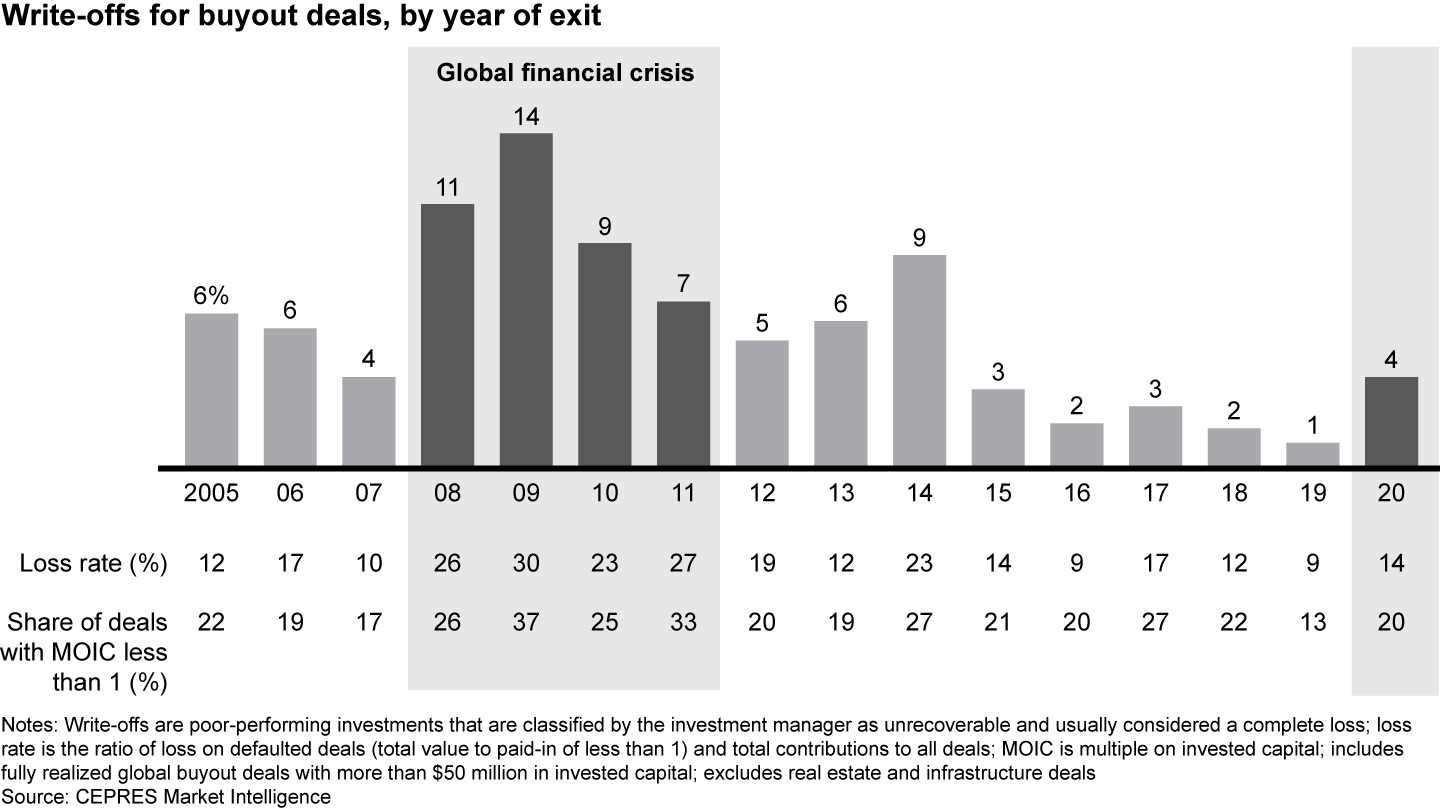
The rapid stimulus boosted confidence that the malaise in the real economy would be temporary. It also made the flood of cheap debt available to fund transactions even cheaper. Rising asset prices and fears of a capital gains tax hike in the US, meanwhile, encouraged sellers to put assets on the market―particularly PE sellers transacting sponsor-to-sponsor deals. The net effect was a second-half surge in large deals that more than made up for the second-quarter drop in value.

SPACs: Tapping an Evolving Opportunity
Here’s how the controversial explosion in special-purpose acquisition companies is unfolding.
The challenge moving into 2021, of course, is that the crisis is still very much with us and its economic impact remains extremely difficult to forecast. Although vaccines are on the way, Bain’s Macro Trends Group projects that challenges to global economies are likely to persist through 2022, and the global regulatory response to this period of crisis could be significant.
This has several important implications for investors in 2021 and beyond:
- The game might not be over for value investors. The great unknown in the wake of the Covid crisis is how long fiscal and monetary policy can hide any underlying structural damage to economies around the world. Eventually the stimulus will wash away, which could remove vital support from sectors that have relied on it. Past downturns tell us that a V-shaped recovery can quickly turn into a W. That could bring down valuations in certain sectors and create the kinds of distressed opportunities that evaporated so quickly in 2020.
- Today’s valuations leave little room for error. Soaring asset prices in sectors like technology mean that multiples for deals getting done today are at or near record highs. The simple math says that GPs buying companies at these prices will have to generate more value if they are to make good on return expectations―and they will have to do so in a highly volatile and uncertain business environment. A Bain analysis of hundreds of funds in which we coinvest shows that multiple expansion and revenue growth (not margin improvement) are by far the biggest drivers of PE returns. Funds will have to find ways to improve that mix if they aim to replicate the returns they’ve posted over the past decade.
- Deep sector and subsector expertise has never been more important. The better you know the sectors you are investing in, the better you’ll understand how they are going to change and how you can take advantage of it. Firms need in-depth intelligence on how the recovery will unfold in a given sector and where the ground has shifted. Many industries have changed fundamentally in the wake of Covid-19 in ways that can alter profit pools. Customer expectations may have evolved; disruptive innovations may have been pulled forward. The firms that can spot change first and build those insights into the PE value chain will have a distinct advantage in the post-Covid future.
- PE firms need to accelerate their plodding transition from analog to digital. Private equity remains a highly labor-intensive, paper-driven industry. The pandemic held up in high relief how inefficient this is. Not every meeting with investors or portfolio company management has to involve a flight, a hotel room and two days’ turnaround time. Interactions can be faster, more frequent and equally effective on Zoom. PE firms have become expert in diagnosing the need for digital change at their portfolio companies. Becoming more competitive in the years ahead will mean bringing those lessons home.
A major element of going digital will be excellence in using tools and analytics throughout the private equity value chain. Before Covid-19 hit, the most effective firms were already deploying artificial intelligence, big data, web-based analytics and other technologies to make smarter, faster decisions about companies and their prospects. Over the past year, they’ve learned that these tools can lead to significantly deeper insights into how industry patterns are shifting, where disruption is coming from and whether their portfolios are prepared for whatever is coming next. Digitally aided due diligence is rapidly becoming table stakes.
It’s safe to say that nobody saw what was coming in 2020. Yet the industry managed to find a way forward. Here’s how the year unfolded in terms of investments, exits, fund-raising and returns.
Bain’s Hugh MacArthur reflects on the resiliency of private equity over the past year and forecasts a busy 2021.
Investments
Having rebounded impressively from a dismal second-quarter performance (North American deal value alone was off 85% from the same quarter a year earlier), the global industry sprinted to the finish in 2020, generating $592 billion in buyout deal value. That was an 8% jump from 2019’s performance and 7% higher than the five-year average of $555 billion (see Figure 6). A full $410 billion of that total came in the third and fourth quarters as GPs raced to put money to work. Confidence reigned that central bank stimulus would prop up the global economy long enough for the worst of the Covid-19 pandemic to pass.
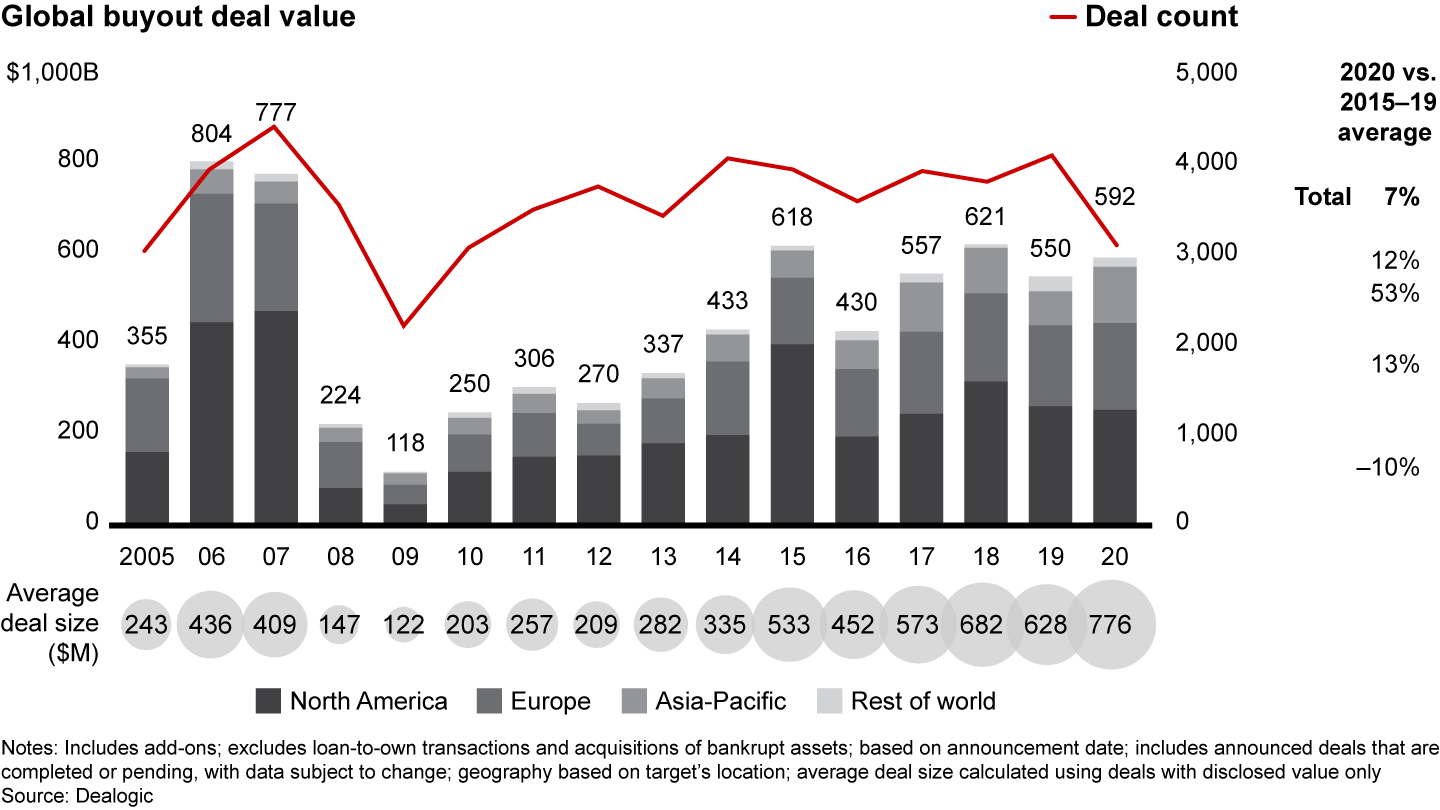
Covid did have a pronounced negative impact on global deal count, as the number of buyouts fell 24% to around 3,100 in 2020, from 4,100 in 2019. With the exception of the technology and telecom sectors, the number of deals slumped across the business landscape compared with the five-year average. The retail, consumer, and media and entertainment sectors were among those taking the biggest hits.
This drop in deal numbers was dramatic, but it is likely to be temporary. Due diligence activity around the world was as strong as it’s ever been in early 2021, suggesting that many of the deals postponed amid the pandemic chaos will eventually get done. That should provide a structural scaffold under 2021 activity.
The reason total deal value rose in 2020 while volume slipped was a 24% increase in average deal size to $776 million. That reflects the ongoing concentration of the PE industry―bigger funds have to do bigger deals to move the needle for investors. Banks also made more financing available for large deals than for smaller ones. In a jittery market, they were most comfortable lending to well-established GPs acquiring large, stable targets.
How deal activity unfolded regionally in 2020 was largely a function of where Covid-19 struck and when. The Asia-Pacific region saw the biggest impact in the first quarter as China wrestled with containing the initial outbreak of the virus. North America got slammed in the second quarter but managed to recover by June. Europe was slower to rebound as activity lagged in both the second and third quarters. It roared back in the fourth quarter, however, and European firms finished the year relatively strong (see Figure 7). Amid the ups and downs, private equity managed to increase its share of total merger and acquisition value, capturing 16% globally.
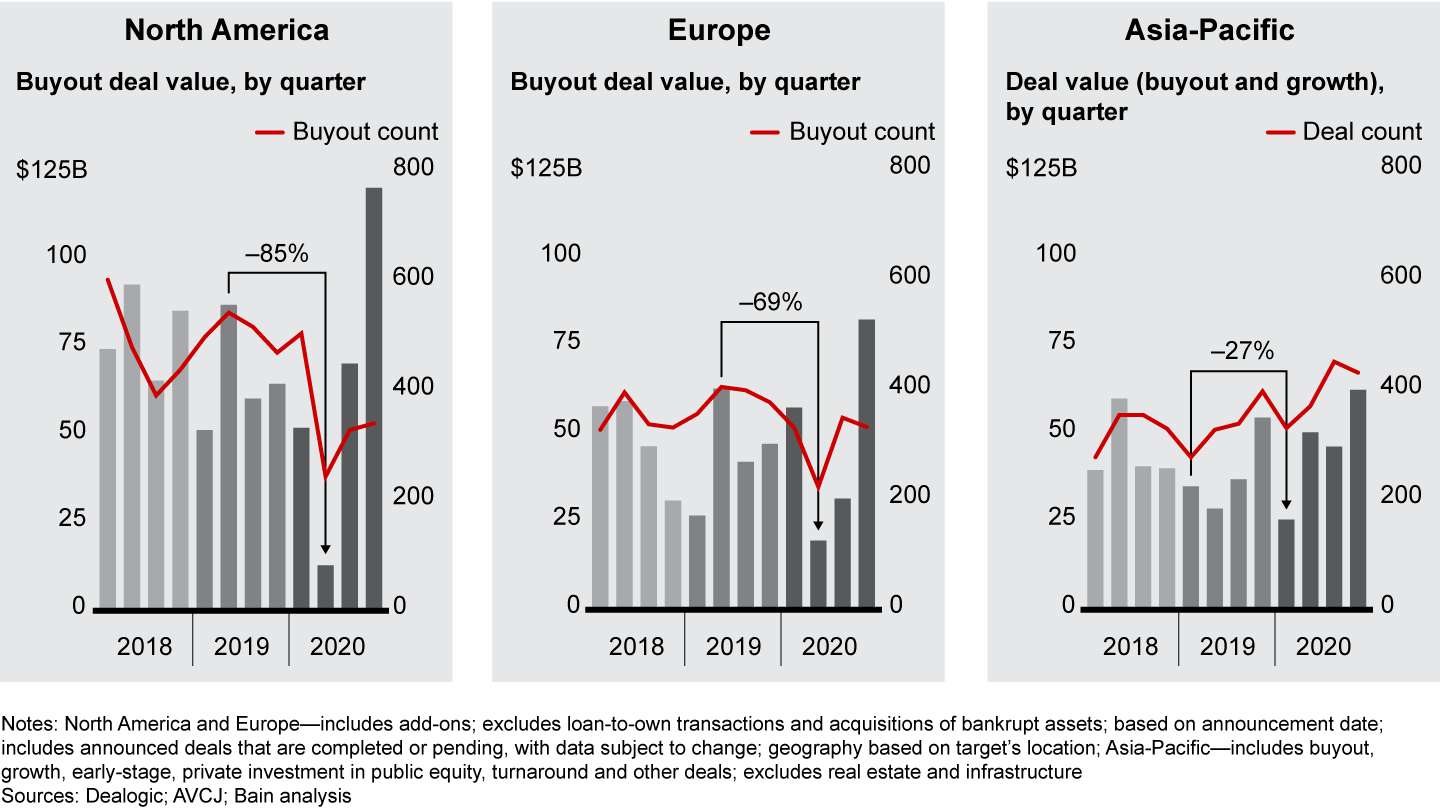
Sky-high asset prices are by far the biggest challenge facing PE investors. According to a December 2020 Preqin survey, investors see asset valuation as the most significant challenge in trying to generate strong returns. Amid heavy competition and a flood of investment capital―both debt and equity―buyout multiples continued to defy gravity in 2020, averaging 11.4 times earnings before interest, taxes, depreciation and amortization (EBITDA) in the US as of year-end and a record 12.6 times in Europe (see Figure 8). As a measure of how hot the market was, around 70% of US buyouts priced above 11 times EBITDA (see Figure 9).
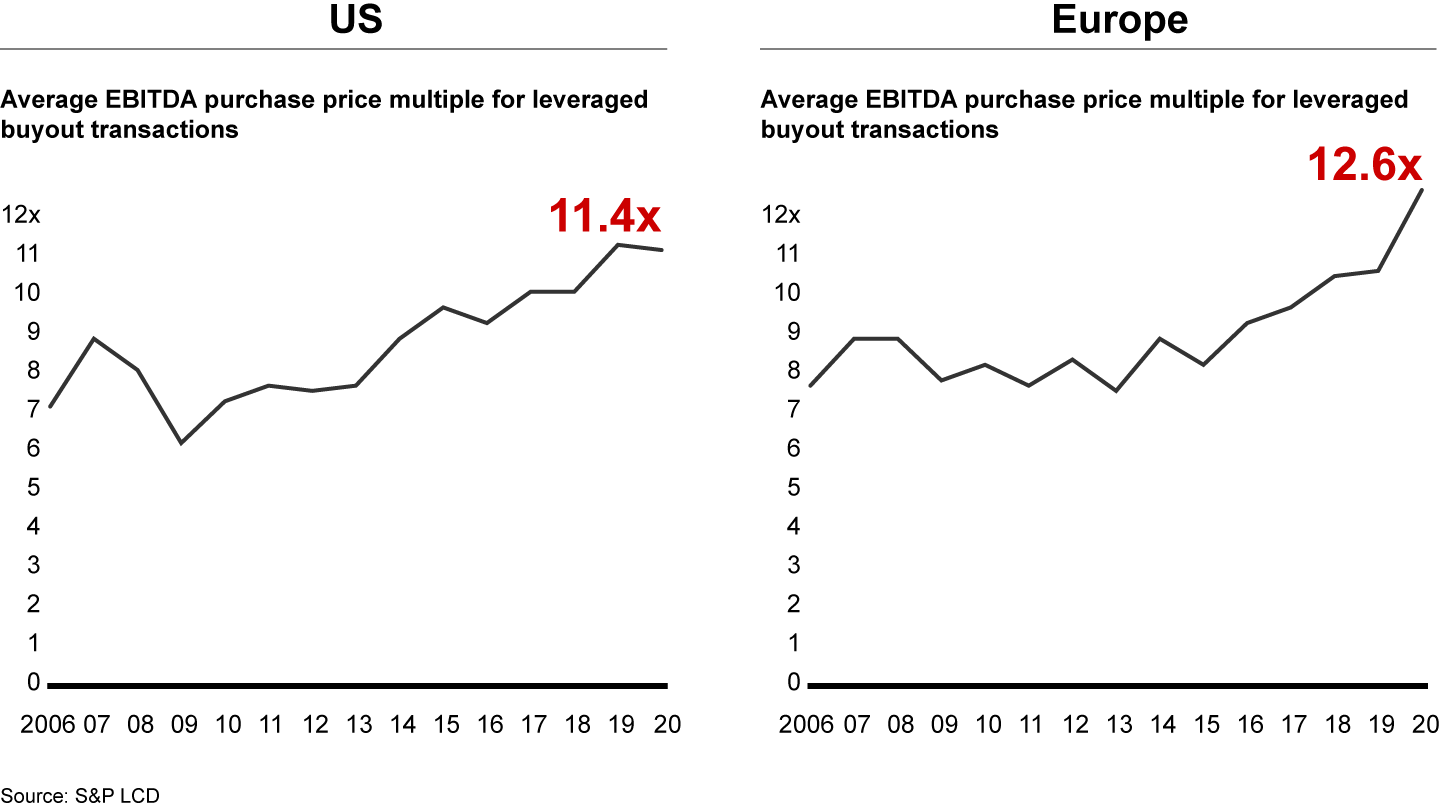

Multiples rose across industries in 2020 but were especially buoyant in the sectors most immune to Covid-19 (such as payments) or those that benefited from the pandemic (like technology). What amounted to a flight to quality meant private equity targeted companies that could support more debt, and banks were happy to supply it. Despite the deep uncertainty surrounding the Covid-19 economy, debt multiples shot up in 2020, with almost 80% of deals leveraged at more than 6 times EBITDA—traditionally the level at which federal regulators start to raise eyebrows (see Figure 10).
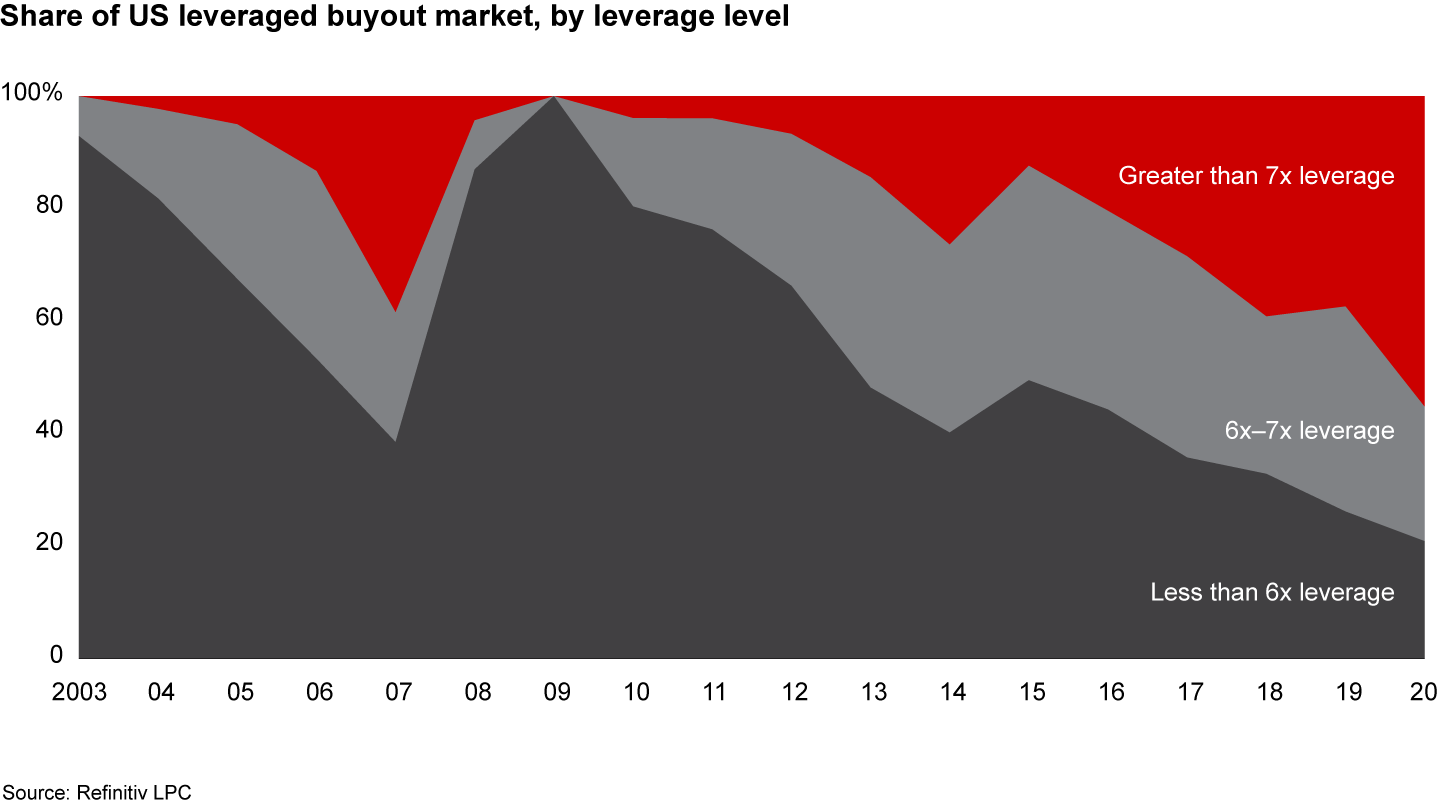
These dynamics have been at play for several years, as limited partners continue to pile money into the industry faster than GPs can put it to work. Unspent private capital overall, including that committed to venture, growth and infrastructure funds, has grown in stair-step fashion since 2013 to almost $3 trillion, with around a third of it attributed to buyout funds and SPACs (see Figure 11).
Buyout dry powder is also at record levels, which is certainly a factor in rising price multiples. But there is little evidence to suggest that buyout funds are under undue pressure to put money to work. While the buildup of unused capital in the overall alternatives market can induce vertigo, the growth in buyout funds has been much more subdued (see Figure 12). The average age of buyout capital remains under control, and the amount in reserve equates to around two years’ worth of investment, far less than in the years following the global financial crisis (see Figure 13). Dry powder is an issue but not a cause for alarm.


Amid the chaos that defined 2020, PE funds showed remarkable resilience. Given the length of the economic expansion leading into the year, most firms had been carefully preparing for an impending recession by focusing on the economy’s most durable seams. Entering the pandemic, however, was like stepping through the looking glass. Traditionally recession-resistant sectors like retail health clinics suddenly turned toxic as stay-at-home orders halted movement overnight. Meanwhile, many of the cyclical sectors that tend to tank in a downturn―home improvement, recreational vehicles, gardening retail―took off like a shot.
The ability to pivot quickly became the key to survival for many portfolio companies. In February 2018, RVshare, a fast-growing peer-to-peer RV rental marketplace, took on a $50 million investment from Tritium Partners to fund growth. But two years later, the pandemic hit with full force and business tanked amid a wave of rental cancellations, which drained cash from the balance sheet. That forced the executive team to scramble for ways to both retain existing customers and find other sources of revenue.
The company cut a deal with Ikea’s TaskRabbit to disinfect every rental before and after the contract period. It began renting vehicles to doctors and utility companies for emergency use. Then, as the summer wore on and camping became a last refuge for the millions forced to cancel more exotic vacations, the company’s fortunes shifted again. Business accelerated and bookings soared. In October, the company raised another $100 million investment led by KKR.
Creative triage was common. Bain Capital’s Apex Tool Group used 3-D printing to make hundreds of face shields for healthcare workers. L Catterton’s ClassPass marketplace launched a new service that enables fitness and wellness providers to live-stream classes and manage appointments through the ClassPass app and website. Edison Partners’ Suuchi pivoted from its core business of providing supply chain optimization software for the lingerie and baby clothing sectors to building a new revenue stream in personal protective equipment.
Entering the pandemic was like stepping through the looking glass. The ability to pivot quickly became the key to survival for many portfolio companies.
Some of the changes companies are making in response to Covid-19 will outlive the pandemic; others will not. Deciphering the new normal and reacting accordingly will be a major challenge for portfolio companies in the months and years ahead. One thing the pandemic has highlighted is that broad sector definitions aren’t that useful anymore. Developing proprietary investment theses and generating strong deal pipelines increasingly will depend on specialized industry knowledge and nurturing proprietary networks of experts and advisers.
Consider healthcare. It is well known that telemedicine and nonhospital care models took off during the pandemic, and PE investment followed. Deals involving outpatient and home care companies more than tripled to $3.9 billion in 2020.
But other, less obvious areas also popped. Life sciences companies that make tests and tools saw huge increases in business as governments and providers scrambled to offer more Covid-19 testing. The same was true for any company that sells tools for vaccine researchers or technology that enables scientists and pharmaceutical companies to collaborate. Indeed, one longer-term effect of the pandemic has been to expose ways in which clinical trials can be improved to rely less on physical interactions. That is opening opportunities for businesses that provide services like remote patient diagnostics and monitoring.
At the same time, healthcare sectors that usually hold up well in a downturn faced increased pressure in 2020 because of delays in elective procedures. Hospitals, ambulatory surgery centers and retail health clinics all suffered, though the impact varied by sector and company. For these businesses, the question is, how long will the Covid effect last, and what will the long-term effects be?
Overall, the number of deals in healthcare held up quite well in 2020. But placing the right bets required real-time understanding of Covid-19’s impact, subsector by subsector, and knowing which of those impacts might alter a company’s trajectory in the future, with both upsides and downsides to consider.
The broad technology sector attracted the most PE investment in 2020 (29% of total buyout deal count globally, 32% including fintech), with several subsectors standing out (see Figures 14 and 15). Funds gravitated toward SaaS-based businesses with particularly sticky business models, like vertical software. Gaming got a big boost from a single deal, a $1.5 billion funding round for Epic Games led by KKR, Baillie Gifford and BlackRock.
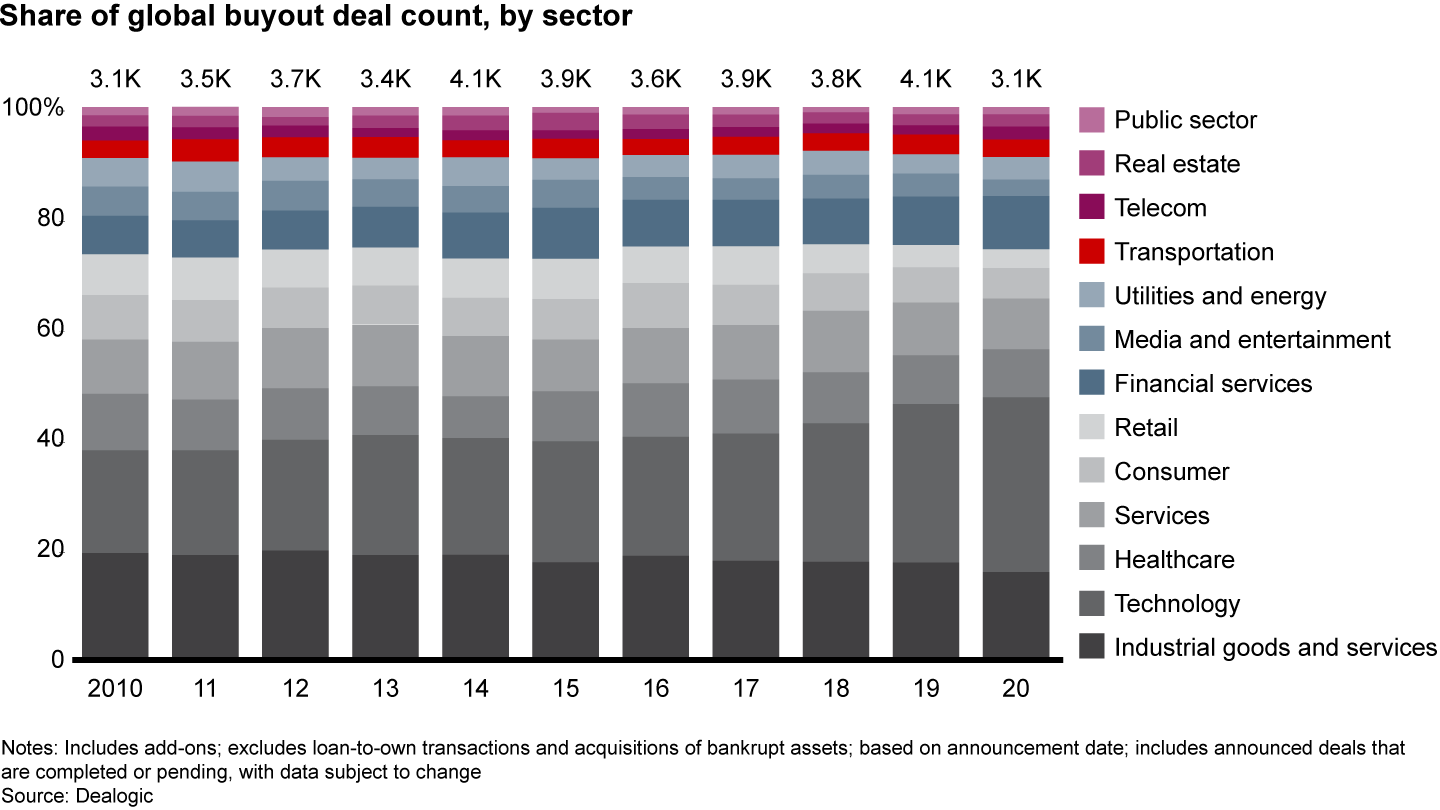

The financial sector also drew significant private equity interest despite the slumping economy, which typically hits the sector hard. But here again, subsector dynamics mattered. Insurance didn’t see much activity, while the payments sector was on fire (as we predicted last year). The secular shift to digital payments that was already well underway got a Covid-19 boost when retailers and consumers alike backed away from cash in favor of cards and other forms of online payment. Deals involving payments companies made up 24% of total financial services/fintech investment value in 2020, up from 16% the year before.
Given that we are still battling the Covid pandemic, the expected strong deal activity in 2021 will likely follow these same patterns. We would expect to see subsectors immune to Covid-19—or given new momentum by the pandemic—continue to attract interest, while hard-hit areas like hospitality, retail and energy may provide rolling opportunities for distressed investing. Amid the continued disruption, private equity firms may need to fundamentally shift their sector emphasis to succeed in this disjointed market. As we’ve noted, deep subsector expertise has never been more important.
Exits
Exit activity in 2020 followed the same pattern as investments. Both buyers and sellers hunkered down when the Covid-19 pandemic hit in the spring, and second-quarter activity went into a skid. But exit value picked up in the second half, as revived price multiples and the threat of a tax-law change in the US gave sellers ample incentive to put companies on the market―particularly big ones. The number of exits trailed 2019’s total, but owing to an increase in deal size, global exit value hit $427 billion in 2020, on par with 2019 and in line with the five-year average (see Figure 16).

Once again, strategic buyers provided the largest exit channel. Sponsor-to-sponsor deals held up well, and initial public offerings increased by 121% to $81 billion as public equity markets soared. Firms also leaned heavily on partial exits, as GPs sought to keep a stake in attractive assets rather than have to hunt down new prospects in a highly competitive deal market. Overall, the median holding period for companies exited in 2020 was 4.5 years, slightly higher than in 2019 but in line with the five-year average (see Figure 17).

Fund-raising
It’s hardly surprising that many GPs were afraid Covid-19 would put an end to the past decade’s golden era of private equity fund-raising. But those fears turned out to be unwarranted. Global fund-raising of $989 billion was a decline from 2019’s all-time record of $1.09 trillion (see Figure 18). But it was still the third-highest total in history, and if you add in the $83 billion raised for SPACs, it was the second highest. All told, the industry has raised almost $5 trillion in capital over the past five years. Buyout funds alone raised about $300 billion in 2020, or $340 billion if you include SPAC capital aimed at buyout-type targets, estimated at $41 billion (see Figure 19).

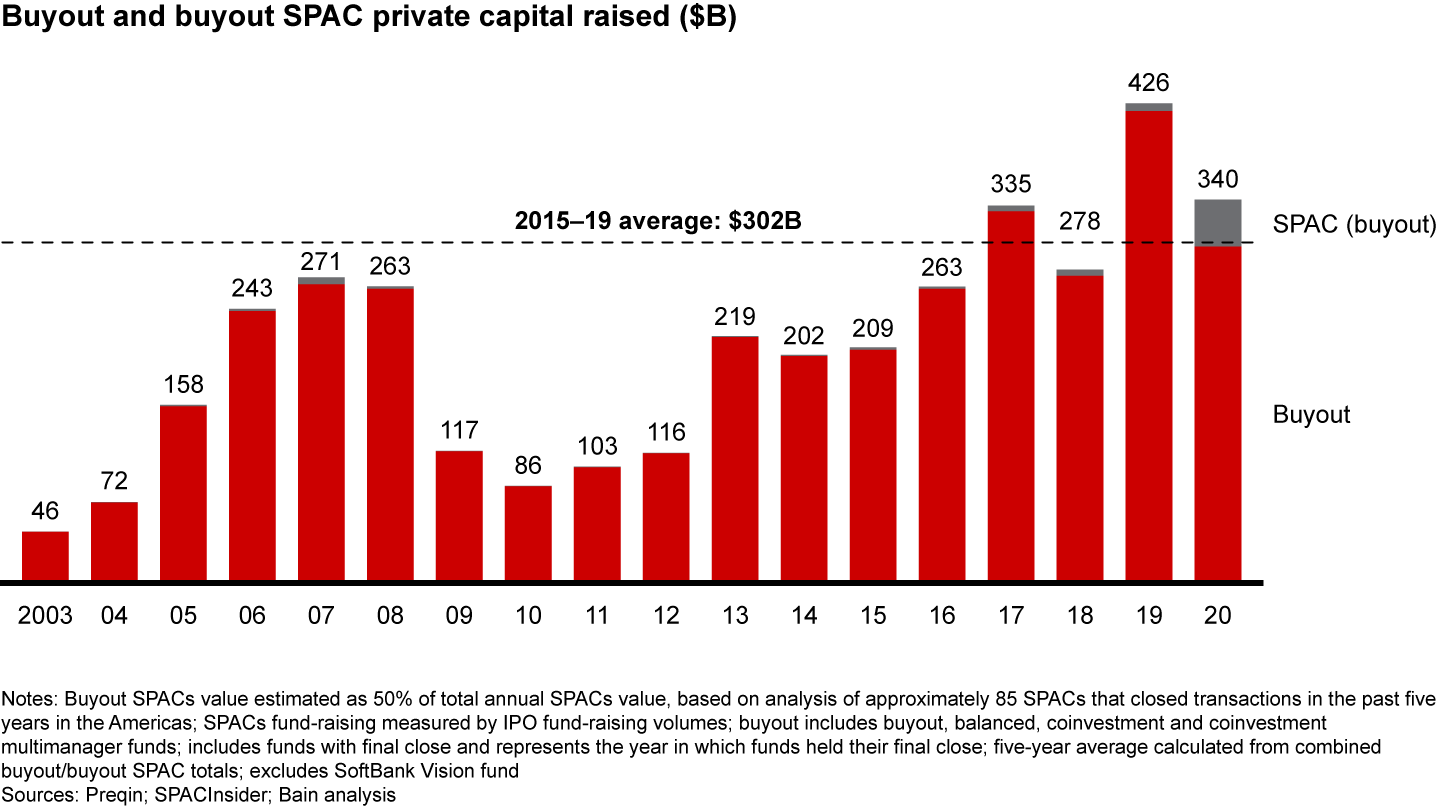
It’s clear that LPs continue to view private equity as a haven in the storm. Institutions did take a pause in April during the first peak of the Covid-19 crisis but quickly got back to business during the summer. According to Private Equity International’s December 2020 LP Perspectives Study, around 80% of LPs are confident private equity will continue to perform in 2021, and close to 40% say they are underallocated to the asset class. The vast majority plan to either increase or maintain their commitments in 2021 (see Figure 20).

As enthusiastic as LPs are, however, they are becoming increasingly picky about the funds in which they invest. A flight to quality in 2020 benefited large, well-established funds most (see Figure 21). Fewer funds closed overall, but those that did skewed large. On average, funds seeking $5 billion or more in assets closed within six months and 18% above their initial target. CVC, for example, raised $24 billion for its Capital Partners Fund VIII in five months and beat its initial target by 22%. By contrast, smaller funds with experience took an average of 14 months to close (see Figure 22).

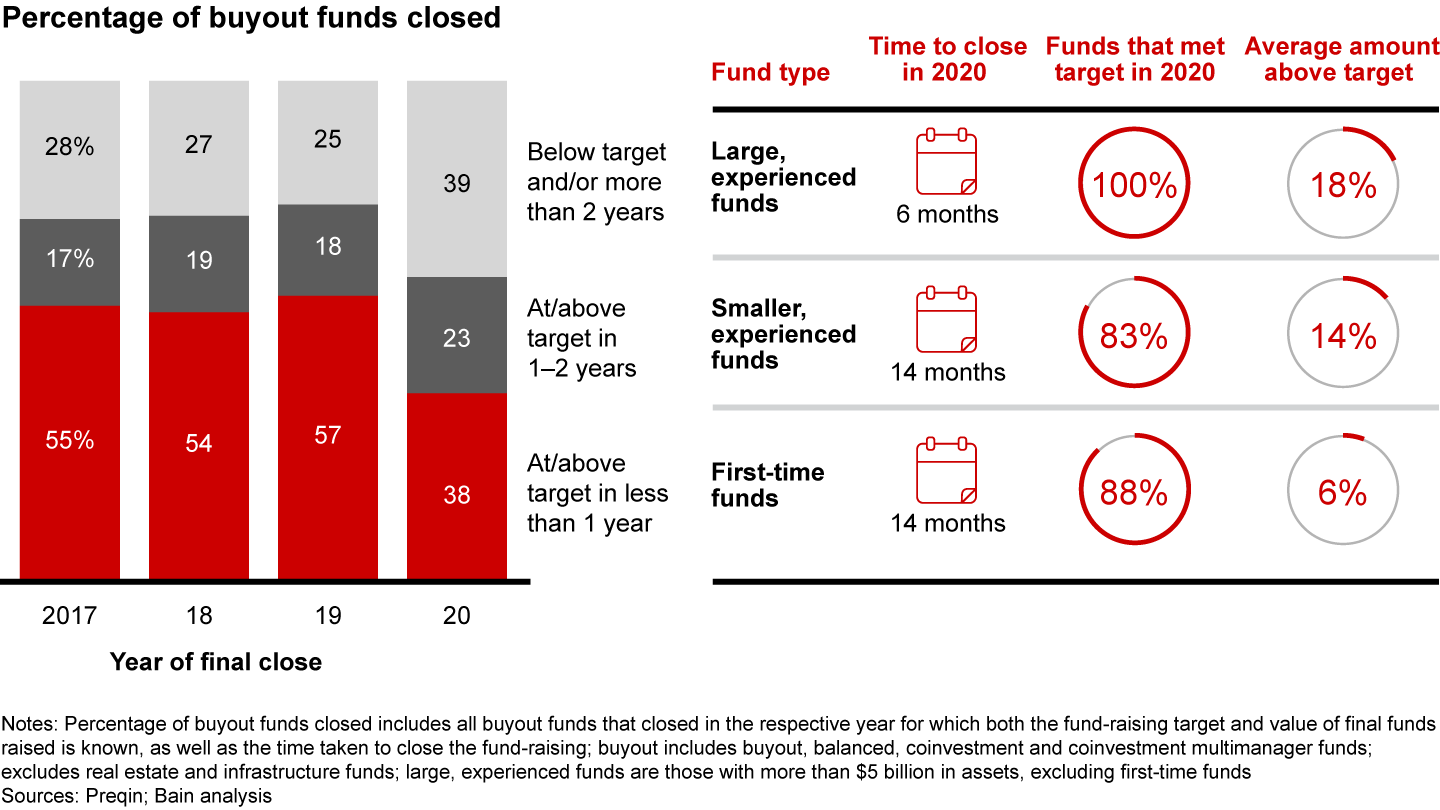
The exceptions to this pattern were funds with a crystal-clear focus. US-based Symphony Technology, for instance, closed its $2 billion Group IV fund in just under six months and was 33% above target. Montefiore Investment raised €850 million in three months with a focus on France. Even a first-time fund like South Korea’s BNW Investment was able to raise $160 million (32% more than it intended) within five months for a fund focused on high-growth, technology-enabled industrial companies.
LPs also showed interest in long-hold funds. Cove Hill raised $1.5 billion in long-hold capital, despite having yet to exit any of the investments made with its initial $1 billion long-hold fund raised in 2017.
Returns
By all indications, private equity weathered 2020’s perfect storm without taking a hit to returns. Looking at 10-year annualized IRR, funds have so far avoided the kind of damage suffered in the global financial crisis (see Figure 23).

It helped to some extent that GPs were already preparing for an end to the record-breaking, decade-long recovery cycle that followed the global financial crisis. But the biggest difference between then and now was the massive government stimulus that buttressed the economy against the worst Covid-19 could dish out. While many sectors saw real damage, many others went untouched thanks to the central banks, and that helped investors maintain or even improve performance across the board.
With the exception of the first quarter, when spooked investors ran for the hills, publicly traded PE firms fared well (see Figure 24). More broadly, while GPs exited fewer deals in 2020, those that did produce exits generated multiples on invested capital of about 2.3 times, slightly above the five-year average (see Figure 25).

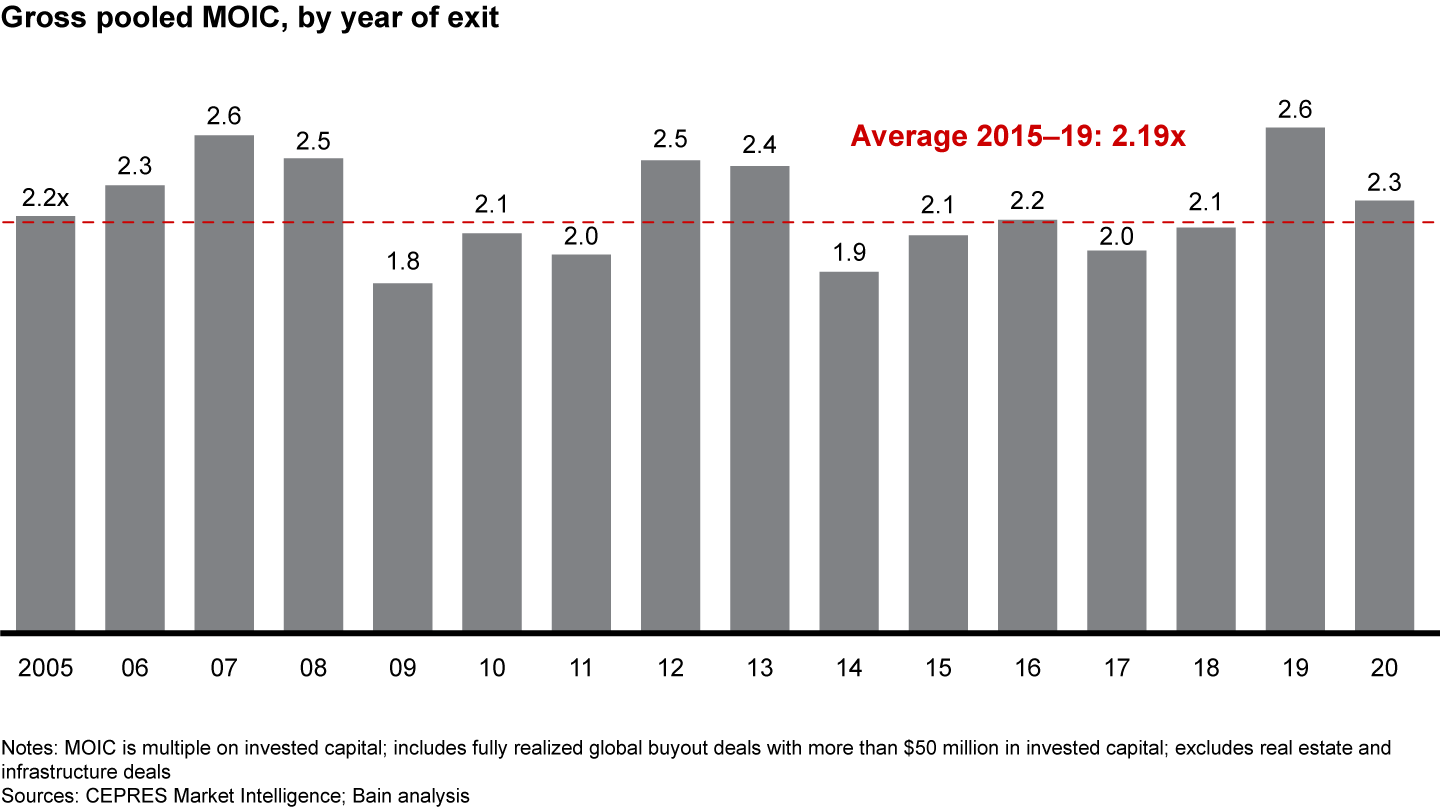
The global industry continues to outperform other asset classes over most time periods. The exception has been US-based fund performance, which has converged with public averages over the past decade (see Figure 26). This owes largely to the public market’s remarkable surge in value since the global financial crisis—an anomaly compared with the long-term average. History suggests that public equity performance will eventually revert to the mean.

What’s becoming increasingly clear is how variable PE performance has been across sectors and subsectors. While technology and business services have soared in the current cycle, the consumer, healthcare, industrials and natural resources sectors (including energy) have fallen off (see Figure 27). There has also been wide variance in performance among deals focused on subsectors of broader industry groups (see Figure 28).
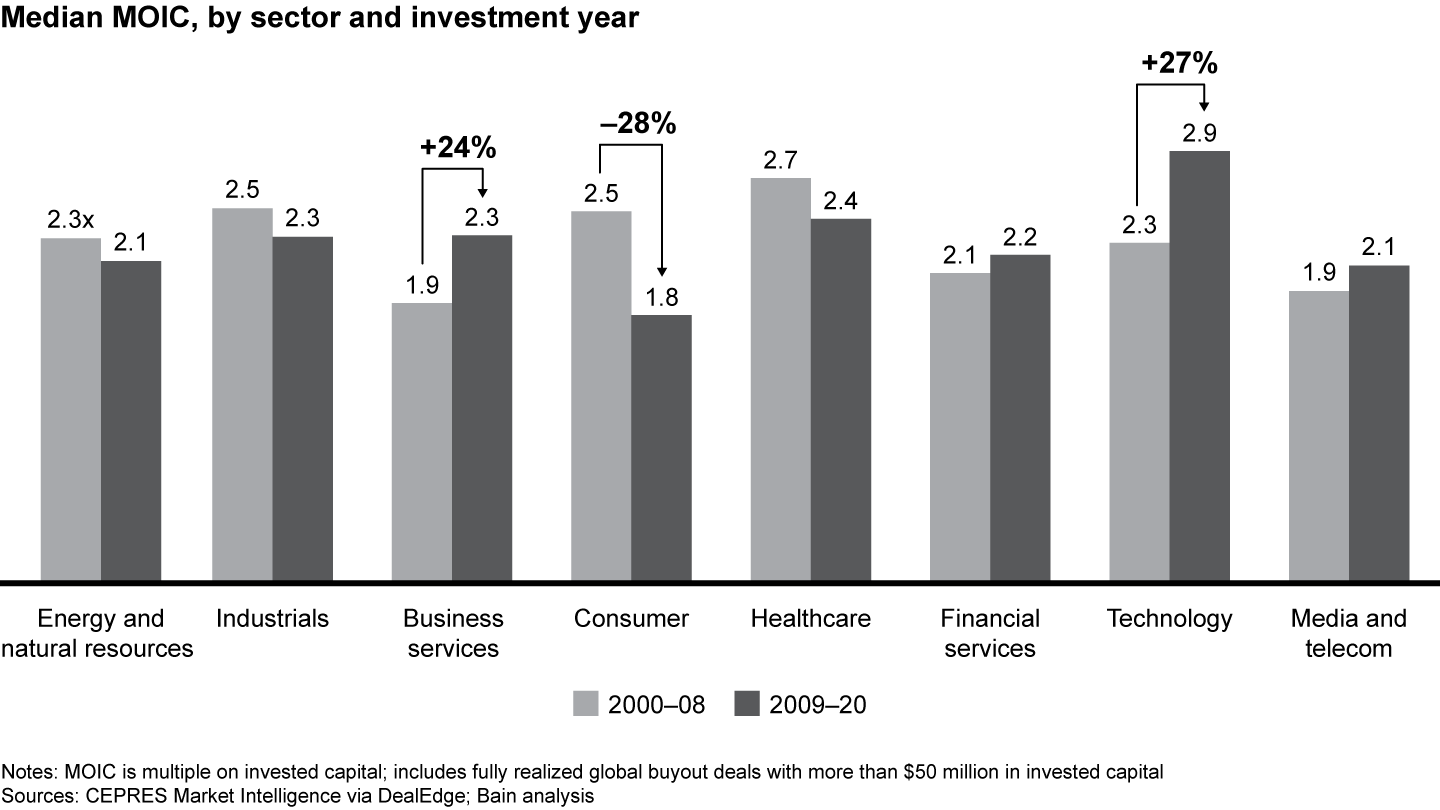
This isn’t to say that simply playing in the right sector is the secret to strong returns. Sector dynamics are not to be discounted, but the choice of company within a strong sector is still more likely to determine deal success. The gap between top-quartile performance and bottom-quartile performance in technology, for instance, has been wide over the past decade. In the otherwise lackluster energy and natural resources sector, top-quartile returns outpaced those of sectors with higher median performance (see Figure 29).
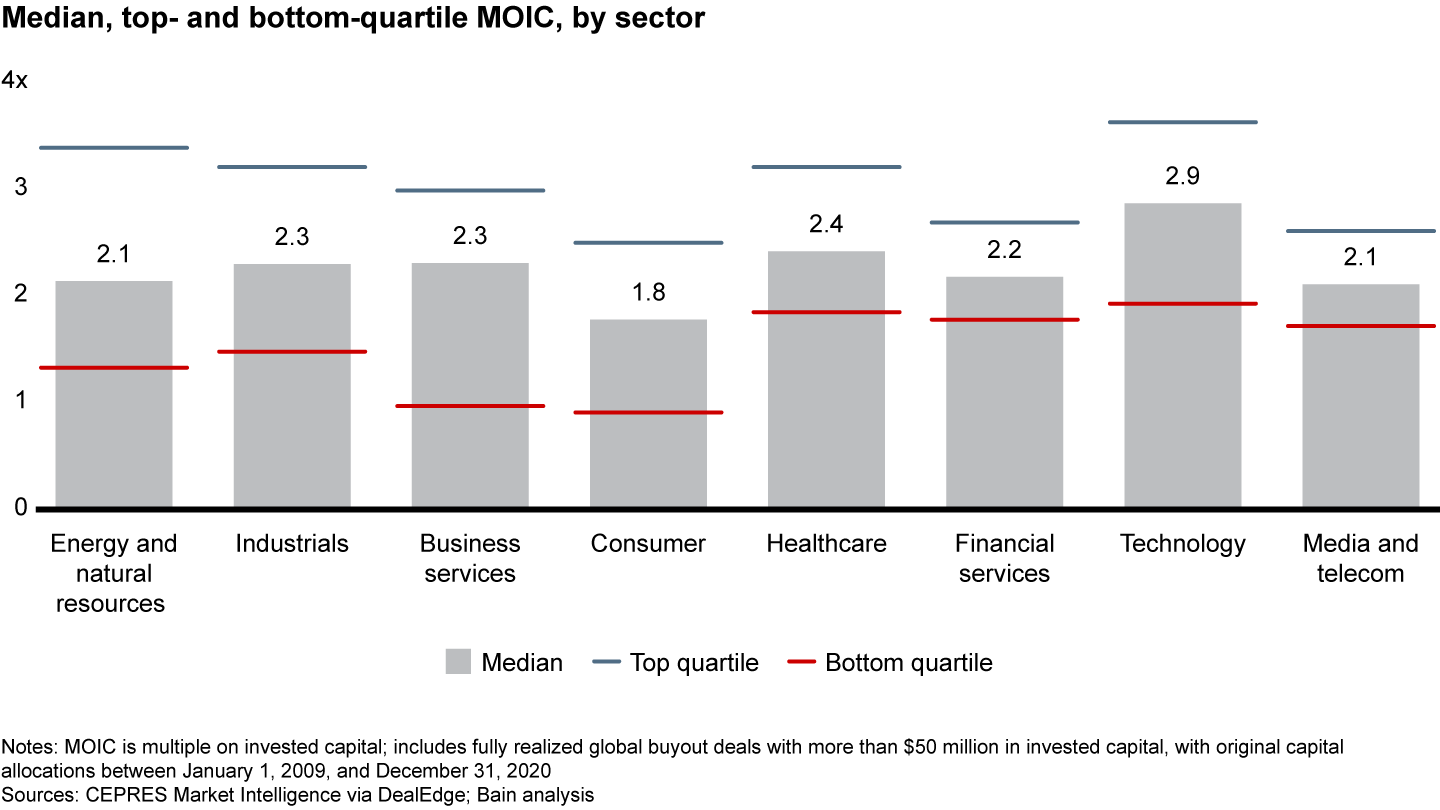
The message is clear: Winning investments exist in every industry. Finding them and creating real value requires both deep knowledge of sector dynamics and a clear thesis describing how a given company can take advantage of them.



























